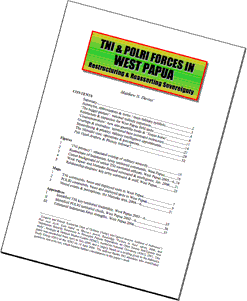Matthew N Davies *
Summary
Download “TNI and POLRI Forces in West Papua” as a PDF.
Since the Aceh peace agreement of mid-2005, Indonesian military planning and operations in and around West Papua2 revealed that area’s priority and emphasis in defence and internal security. Upon the voyage of 43 asylum seekers to Australia in January 2006, West Papua’s situation also took renewed prominence in bilateral diplomacy with Indonesia’s southern neighbour.
The confrontational Indonesia-Australia diplomatic posturing from early 2006 occurred amid a nationwide Indonesian plan for military expansion. Publicly available detail confirmed much of the general planning, and major parts of its achievement, where changes appeared in locally based and deployed force composition, territorial structure and senior command and staff appointments. New local infantry formations reduced the dependency on centrally deployed units, while new special operations forces paralelled concurrent developments in other sites of Indonesian countersurgency. The issue of counterterrorism facilitated much of the political and bureaucratic means crucial for renewed TNI dominance of Indonesia’s polity.
Recent events surrounding the voyage by 43 asylum seekers to Australia indicated sophisticated TNI-run psychological operations combining strategic-level concerns with past methods of infiltration and manipulation into West Papuan resistance groups and their sympathizers. Arrangements in command and control, alongside key officers’ operational expertise and record, further indicated a TNI campaign to penetrate the Australian Government’s leadership elite’s ‘decision cycle’, or its basic, driving psychological processes around informal migration to its shores. Beneath the Indonesian military’s planned ambitious and expensive, ongoing build-up and renewal, that most recent episode in Indonesian-Australian diplomacy indicated the Jakarta leadership elite’s strategic-level success in West Papua operations. Such success would likely see West Papua become the table on which Indonesian leaders could bargain for the most beneficial results of a restored bilateral security treaty with Australia.
| Contents | ||
|---|---|---|
| Summary | 2 | |
| Acronyms, abbreviations & terms / main military symbols | 3 | |
| ‘The bigger picture’: national military expansion | 4 | |
| Restructure & expansion for West Papua field units | 6 | |
| ‘Counterterrorism’: new anti-guerrilla mode & ‘Trojan horse’ | 11 | |
| Overlaps & anomalies: territorial base command restructure | 14 | |
| Streamlining & priority: military intelligence appointments | 21 | |
| The Merauke case: operations & perceptions | 29 | |
| Pak Ogah Arafuru & Phoney Infowar? | 32 | |
| Figures | ||
| 1 | ‘TNI primacy’: structural overlap of military seniority | 15 |
| 2 | Restructure of Indonesian Army territorial commands, West Papua | 16 |
| 3 | Career background of senior TNI territorial officers, West Papua 2005-6 | 19 |
| 4 | West Papua- and Merauke-focused command & intelligence, Jan. 2006 | 21 |
| 5 | Relationship diagram: key army command & staff, West Papua | 25 |
| Maps | ||
| 1 | TNI commands, bases and deployed units in West Papua | 7 |
| 2 | POLRI commands, bases and deployed units in West Papua | 9 |
| 3 | Mixed events & perceptions: the Merauke area, 2004-6 | 31 |
| Appendices | ||
| I | Identified TNI key territorial leadership, West Papua 2002-6 | 35 |
| II | Identified POLRI territorial chiefs, West Papua 2002-6 | 36 |
| III | Estimated Indonesian force strengths, West Papua 2006 | 37 |
Information about the author
Matthew N Davies is a linguist and former Australian Department of Defence (Army) intelligence analyst.
Author of Indonesia’s War over Aceh: Last stand on Mecca’s porch, Routledge ‘Politics in Asia’ series, 2006, and ‘Indonesian Security Responses to Resurgent Papuan Separatism: an Open Source Intelligence case study’, Strategic & Defence Studies Centre (SDSC), Australian National University (ANU), 2001.
This paper was researched from April to July 2006, and is largely based on a briefing given to the Indonesia Study Group (ISG) at the ANU on 14 June 2006. The author thanks ISG attendees who contributed questions and criticism, which became further consideration in this paper’s draft.
The views expressed in this article are those of the author and do not necessarily reflect the official policy or position of the Nautilus Institute. Readers should note that Nautilus seeks a diversity of views and opinions on contentious topics in order to identify common ground.
Produced by the Nautilus Institute at RMIT, Austral Peace and Security Network (APSNet). You can review the 2006 archives. You might like to subscribe to the free bi-weekly newsletter .



One thought on “TNI and POLRI Forces in West Papua: Restructuring & Reasserting Sovereignty”